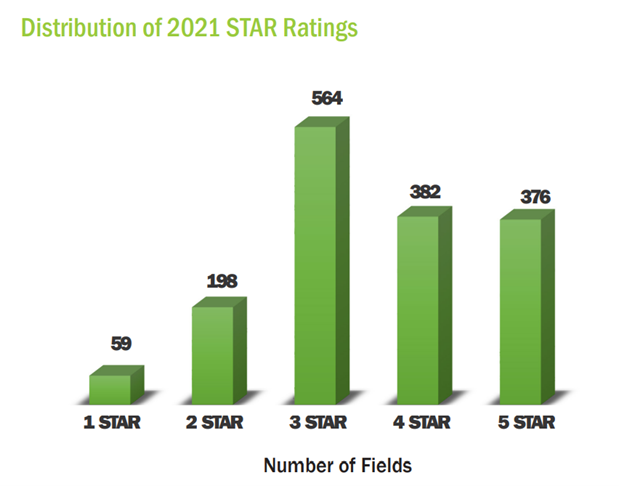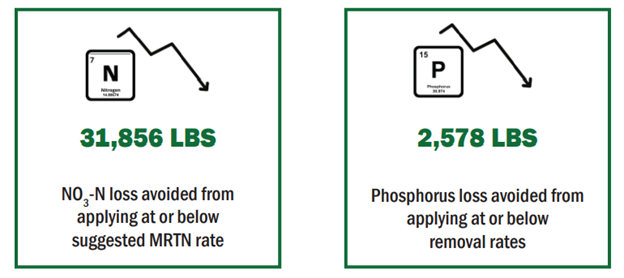Saving Tomorrow’s Agriculture Resources (STAR) has concluded its third year of reporting conservation efforts in and around the state of Illinois through the Crop Year 2021 STAR Annual Report. The report features a summary of conservation efforts, environmental impacts, and growth of the STAR initiative.
STAR is a free nation-wide tool that assists farm operators and landowners in evaluating their nutrient and soil loss management practices on individual fields. It was created by the Champaign County Soil and Water Conservation District, developed in 2017 as a means to contribute to the important goals outlined in the state’s Nutrient Loss Reduction Strategy, namely through soil health and water quality improvements. STAR encourages participants to use best management practices that will reduce nutrient and soil losses on their fields. The initiative utilizes a simple, 5-minute field form that assigns points for each cropping, tillage, nutrient application, and soil conservation activity on individual fields. Once the field form is completed, the information is entered into a spreadsheet that assigns various points for the different practices used on that field. The summary of those points is then compared to a scale of points to give that field a “STAR Rating” of one to five STARs.

For the 2021 crop year, 472 participants utilized the STAR tool on 85,579 acres over 1,579 fields. In Illinois, 69 Soil & Water Conservation Districts locally administered the program, providing one-on-one technical assistance to farmers and landowners interested in improving their STAR Rating. In 2021, the use of cover crops by STAR farmers in Illinois kept 11,666 tonnes of greenhouse gas (GHG) emissions out of the atmosphere and kept 25,940 tons of sediment in the field, and out of Illinois waterways. The use of no-till and strip-till by STAR farmers kept 27,276 tonnes of GHGs out of the atmosphere and 47,752 tons of sediment out of Illinois waterways.

“Farmers are making tremendous strides in protecting land and nutrients as input prices and availability stay in flux,” says Megan Dwyer, Director of Conservation and Nutrient Stewardship with Illinois Corn Growers Association. “The STAR tool brings farmers an opportunity to measure their practice efforts and develop plans for next season.” STAR’s usage also shows its importance as growing seasons show abnormal conditions. As the 2021 growing season saw above average growing temperatures with below average rainfall throughout the state, the annual report noted a high proportion of enrolled farmers still maintaining 3-STAR or above ratings for their fields.

This year was also the debut of the STAR Web Application, which further increased accessibility for farmers and landowners. In prior crop years, field forms were submitted using a digitally fillable or printable PDF form. To increase convenience and improve outreach, STAR launched a dedicated Web App for 2021, designed to offer immediate, automatic scoring as well as a customized improvement plan based upon said scoring.
Coming out of a virtual year, the STAR team also sought face-to-face engagement with farmers to discuss improvement plans, explore opportunities for conservation, and develop partnerships with other programs. As part of this outreach initiative, STAR visited with over 1,900 individuals through conferences, field days, and trade shows.
The improved accessibility of STAR has led to increasing landowner usage in each crop year since its inception in 2017. As of July 2022, the STAR initiative has been administered by various Soil and Water Conservation Districts within Colorado, Illinois, Indiana, Iowa, and Missouri. Colorado Department of Agriculture and the Conservation Districts of Iowa implemented Colorado STAR and Iowa STAR, respectively, for the first time in 2021. Hundreds of farmers and landowners have enrolled in the program annually, recording hundreds of thousands of acres of land continuously adopting conservation-focused practices. Due to these efforts, thousands of tons of greenhouse gas emissions are kept out of the atmosphere, and tens of thousands of tons of nutrients and sediment are retained in the field each year. STAR continues to improve and expand, and the initiative anticipates these reductions to continue to increase in 2022 and beyond.
To read the full report and learn more about the practices supported by STAR, visit https://bit.ly/STARAnnualReport. The 2022 field form is currently available through the STAR Web App at https://starfreetool.com or through a Soil & Water Conservation District near you!